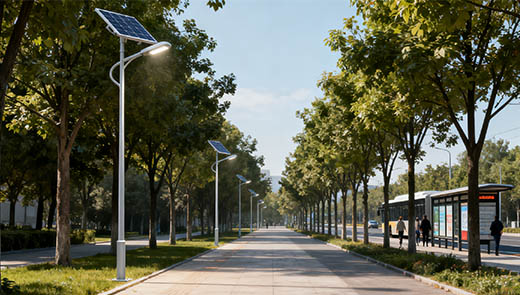Best Solar Street Light Battery Options in 2025
In the process of modern urban and rural development, the importance of solar street lights has become increasingly prominent. Not only do they provide stable lighting for roads, paths, and parking lots, but they also contribute significantly to energy conservation and environmental protection due to their ability to operate independently of the power grid, making them an important component of sustainable development. In solar street light systems, batteries serve as the core energy storage components, and their performance directly determines the lighting effectiveness, service life, and reliability of the street lights. Selecting the appropriate battery ensures that solar street lights operate efficiently in various environments. Conversely, an improper choice may lead to issues such as insufficient lighting or frequent replacements.
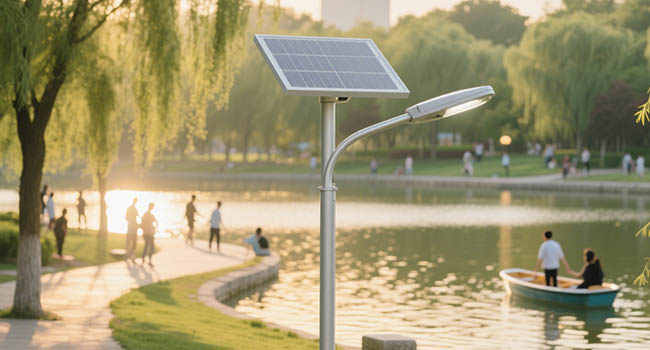
How Street Light Batteries Function in Solar Systems
In solar street light systems, batteries are the core of energy storage, working in tandem with solar panels, LED lights, and charge controllers: During the day, solar panels absorb sunlight and convert it into direct current. Under the voltage regulation of the charge controller, electrical energy is safely and efficiently stored in the battery to prevent overcharging damage. At night, when sunlight diminishes, the battery releases stored energy to power the LED lights. Some advanced systems also use motion sensors or dimming modes to regulate discharge, conserving energy and ensuring stable lighting at night, thereby achieving continuous operation independent of the grid.
Types of Batteries for Solar Street Lights
Lead-Acid Batteries
Lead-acid batteries are cost-effective, making them attractive for budget-constrained projects. They offer reliable performance with low maintenance requirements, and improved versions like AGM and GEL can enhance performance. However, they have a shorter lifespan (approximately 3–4 years), lower cycle life (300–500 deep cycles at 50% discharge depth), and efficiency significantly decreases as discharge depth increases.
GEL Batteries
GEL batteries require no maintenance, maintain good performance over a wide temperature range from -40°C to 65°C, and have a longer deep cycle lifespan (500 to 800 cycles, approximately twice that of standard AGM batteries). However, they are more expensive, sometimes even exceeding the cost of lithium-ion batteries, and the higher cost may make them unaffordable for some projects.
Lithium-Ion Batteries
Lithium-ion batteries have high energy density, enabling them to store more energy in a smaller space. Their compact size makes them suitable for urban environments with limited space. Their low self-discharge rate improves the efficiency of solar street lights, and they have a long lifespan (500–800 charge cycles) with minimal maintenance requirements. However, the initial investment is high, though the long-term cost savings and excellent performance often justify the investment.
Lithium Iron Phosphate Batteries
Lithium iron phosphate batteries are highly safe, do not burn or explode, have a long lifespan (6–10 years), and are a reliable choice for long-term solar lighting projects. They have high energy density and deep cycle capability with 1,500–2,000 charge cycles, require no maintenance, and can withstand extreme weather conditions. While the initial cost is higher than some other options, it is reasonable from a long-term cost-benefit perspective.
Flow Batteries
Flow batteries can discharge up to 100% of their capacity, are scalable, and have more charge/discharge cycles than other battery technologies. They perform well in low-temperature environments. However, their complex design and operation, along with high costs, limit their application in solar street lights. They are better suited for large-scale energy storage solutions rather than small-scale solar street light systems.
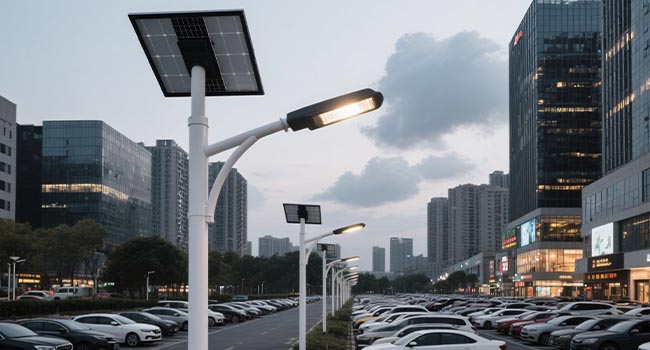
Key Factors in Choosing a Solar Street Light Battery
Voltage
When selecting a solar street light battery, voltage is a relatively simple yet critical factor. The selected battery must meet the voltage requirements of the street light. Fortunately, modern street lights typically have high energy efficiency, meaning that high-voltage batteries are generally not required for normal operation.
Efficiency
Not all electrical energy input into a battery is ultimately released. In fact, efficiency varies significantly between different types of batteries. Generally, the round-trip efficiency (i.e., the efficiency of the entire charge-discharge cycle) of high-quality solar street light batteries is approximately 80%. The higher the efficiency, the more reliable the solar street light becomes.
Temperature Range
For solar street light batteries, temperature range is an often overlooked yet critically important characteristic. Unlike indoor batteries, which operate in a relatively stable temperature environment, outdoor batteries must withstand extreme temperature fluctuations throughout the year. Temperatures can drop below freezing in winter and exceed 30°C in summer.
The selected solar street light battery must be able to reliably withstand these extreme temperatures. Especially in winter, where cold weather and long nights coexist, the battery's performance at low temperatures must not significantly decline to ensure the solar street light operates normally throughout the night. This is because in cold environments, both charging and discharging speeds slow down, thereby affecting the battery's efficiency. Therefore, it is advisable to choose batteries that perform well under extreme temperatures and implement insulation measures to minimize the impact of low temperatures on the battery.
Lifespan
When investing in new solar street light batteries, it is crucial to choose batteries that can operate efficiently over the long term. Frequently replacing or repairing batteries nearing the end of their lifespan can be a hassle, so selecting batteries with a longer expected lifespan (or cycle life) is more advantageous. It is important to note that how batteries are used can also affect their cycle life. For example, a battery with an 80% discharge depth may have a significantly shorter cycle life than one with a 50% discharge depth.
When selecting solar street light batteries, it is essential to consider the warranty period they offer, as this can provide some indication of the battery's expected service life. If a battery has a warranty period of only a few years, it may be worth exercising caution, as this suggests the manufacturer lacks sufficient confidence in its ability to function normally over the short term.
Cost
When selecting the best solar street light battery, price should not be the primary consideration, but it can still influence the final decision. Especially when a large number of batteries need to be installed, costs can quickly accumulate. Therefore, it is important to find batteries that are both high-quality and cost-effective.
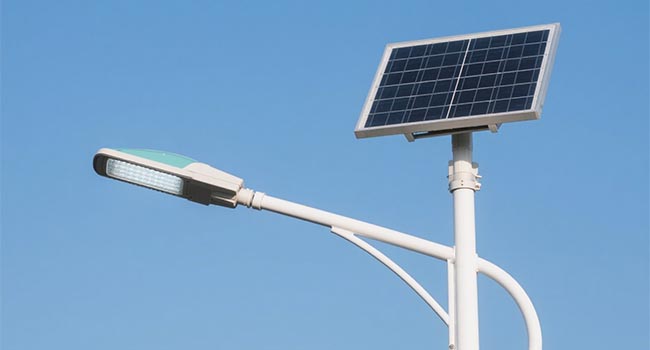
Best Battery Choices for Specific Needs
When to Choose Lead-Acid Batteries
Lead-acid batteries are widely used in solar street lights due to their low cost and reliability. They are ideal for projects with moderate energy requirements and tight budgets. The recommended discharge depth for lead-acid batteries is 20%, with 30%-40% also acceptable. However, it is important to note that a significant increase in discharge depth can significantly shorten their lifespan.
For cost-sensitive projects, lead-acid batteries offer an economical solution. Their low maintenance requirements and reasonable service life make them suitable for many solar street light applications, especially when budget constraints are a primary consideration.
When to Choose GEL Batteries
GEL batteries excel in scenarios involving frequent deep discharges, as they can withstand frequent cycles without significant performance degradation. In applications requiring deep discharge capability and stable performance across a wide temperature range, GEL batteries are often the preferred choice.
When to Choose Lithium-Ion Batteries
Lithium-ion batteries are renowned for their high energy density and compact size, making them ideal for integrated solar street light applications. Their discharge depth of up to 75% helps extend the operational runtime of street lights. Lithium-ion batteries maintain performance even under low-light conditions, ensuring consistent and stable illumination throughout the night. While the initial investment may be higher, the long-term savings and performance advantages often justify the cost.
When to Choose Lithium Iron Phosphate Batteries
Lithium iron phosphate batteries (LiFePO4) are extremely durable and offer a longer cycle life and superior safety compared to other lithium-based batteries. Their excellent thermal stability makes them safer for use in outdoor environments. Lithium iron phosphate batteries perform well in high-temperature conditions and offer a long service life and reliability in solar lighting systems. These batteries are ideal for projects requiring long-term reliability and low maintenance. They can withstand extreme weather conditions without compromising performance, further solidifying their position as the top choice for solar street lights.
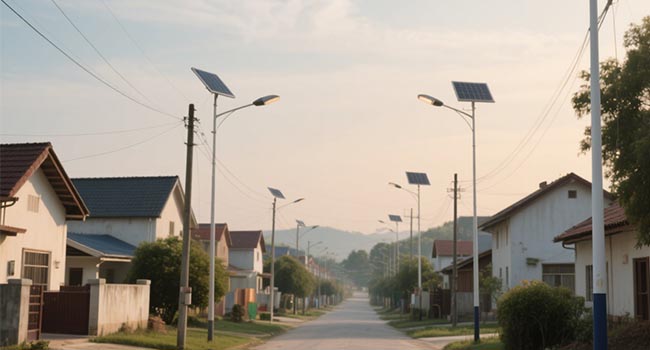
Benefits of Lithium Iron Phosphate Batteries
Efficiency in Charging
|
Battery Type |
Charging Efficiency |
Daily Stored Power from 100W Solar Panel |
Supported Light Power (Same Capacity) |
|
LiFePO₄ Battery |
100% |
45W - 75W |
60W |
|
Lead-Acid Battery |
60% |
27W - 45W |
30W |
As shown in the table above, lithium iron phosphate batteries have a much higher charging efficiency than lead-acid batteries. This means that with the same solar panel configuration, lithium iron phosphate batteries can store more energy, enabling them to power higher-wattage lights and achieve better lighting effects.
Excellent Discharge Performance
Lithium iron phosphate batteries have stable discharge voltages and can achieve 100% discharge at room temperature. Lead-acid batteries, however, can only discharge up to 60%-70%. Taking a 12V 50AH battery as an example, a lithium iron phosphate battery can release 50AH of electricity. If a street light operates for 10 hours each night, it can run continuously for two days. Under the same conditions, the charging performance of lead-acid batteries is only half that of lithium iron phosphate batteries, and they can only release half the energy, i.e., only 12.5AH, which is sufficient to power the street light for half a day.
More Suitable Size and Weight
Lithium-ion batteries have a volumetric energy density as high as 100Wh/L, meaning they are smaller in size than lead-acid batteries and are not restricted by space during installation. A lithium iron phosphate battery of the same capacity weighs only half as much as a lead-acid battery.For example, a 12V 120Ah lithium iron phosphate battery measures 260x169x218mm and weighs 16kg. A 12V 100Ah lead-acid battery measures 407x173x210mm and weighs 32.7kg. Clearly, lithium iron phosphate batteries are more compact and lightweight, making them easier to install and maintain.
Low Maintenance Cost and Long Service Life
After 2,000 cycles, lithium iron phosphate batteries can still retain over 80% of their rated capacity and can be used for 7-8 years under normal conditions. In contrast, lead-acid batteries need to be replaced every 6 months to 1 year. During the charging and discharging process of lithium iron phosphate batteries, the volume changes of the positive and negative electrodes are opposite, so the overall volume of the battery remains unchanged, resulting in less pressure on the separator, ensuring the battery's safety and cycle life.
Lead-acid batteries require charging every three months during storage, while lithium iron phosphate batteries have excellent storage performance, capable of being stored for up to 3 years without charging or maintenance, reducing labor costs and pollution. Additionally, the monthly self-discharge rate of lithium iron phosphate batteries is approximately 2%, with a capacity recovery rate exceeding 98%.
Among the various battery options for solar street lights in 2025, lithium iron phosphate batteries stand out as the core choice that balances long-term reliability and cost-effectiveness, thanks to their efficient charging and discharging, ultra-long lifespan, exceptional safety, and adaptability to extreme environments. Whether for urban and rural roads, park paths, or remote area lighting, they provide stable performance to support solar street lights in continuously delivering energy-saving and environmentally friendly value, making them the preferred energy storage solution for promoting sustainable lighting development.


